Foreign Insulators
by Marilyn Albers
Reprinted from "INSULATORS - Crown Jewels of the Wire", February 1984, page 6
More Insulators from Finland and Russia
Do you still have your July '80 and April '82 issues of Crown Jewels?
It's not absolutely necessary, but in both of these my "Foreign
Insulators" column showed pictures of Finnish insulators, and some of the
markings were explained. Since then I have learned even more about these
markings and the insulator manufacturers. Referring to these two back issues may
help you to better understand what follows.
What brought this most recent
information to light was that in reading the April '82 column, my friends Nick
and Raija Antonow (Ashbury, New Jersey) saw my many unanswered questions, and
again wrote to Mr. Pentti Muukari in Finland asking for help. He did respond,
and through a translation of his letter we know a lot more now than we did
before.
Nick and Raija were also at the NIA National Show in Rochester last
summer with quite a table full of Finnish insulators and a few from Russia.
Needless to say, several of these went home with me! They tell me that most of
the Finnish ones came from Mariehamn, the capital city of the Swedish speaking
┼land Islands, which belong to Finland, but are to the southwest and closer to
Sweden. Pictures of these follow below.
|
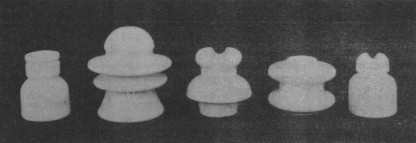
| Fig. 1 |
Fig. 2 |
Fig. 3 |
Fig. 4 |
Fig. 5 |
|
Figures #1 through #5 are porcelain and
are made for electrical use. They all carry the incuse trademark of Turku
Potteries (shown at right), which is located in Turku, Finland.

Figure #1 is a
"dry spot" insulator. It has no cover, but is open at the top. Nick
and Raija say not, but I still believe some sort of a cap, either metal or
porcelain, was meant to clamp over the opening; otherwise its purpose as a dry
spot would be defeated, and the wire going down through the hole would not stay
dry. There is even a ridge to hold one in place. Have any of you readers ever
seen one without a lid? If so, I am most willing to be shown!
Figures #6 and #7
are also power insulators and are marked simply ARABIA (as above right),
followed by various numbers and letters to indicate style number, use, or date.
According to Pentti Muukari, insulators bearing this trademark are manufactured
by the Turun Porsliini factory, which is a subsidiary of the parent company Oy
Arabia Ab, located in Helsinki. Arabia Potteries make just about everything in
porcelain, from fine pottery to commodes. There are representative offices in
North, Central and South America, Europe and Africa.
The next two photos show
three power insulators all about the same size. Figure #8 is similar to U-1638
and made of porcelain. It is unmarked. Originally it was fired with a white
glaze, but was later painted a salmon red. Nick Antonow says the reason is,
"so that the insulators would not show on aerial view photography during
the (Second World) War. Check the location of the ┼land Islands on your map.
They are right en route from Russia, over Finland, to Sweden and
Stockholm."
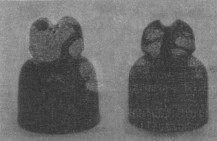
|
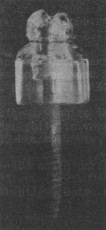
Fig. 10 |
Figure #9 is a glass counterpart in a deep clear amber. Figure
#10 is exactly like it, except that it is of clear glass. Neither have any
markings. This particular design has been assigned a new C.D. # -- 509. Both came
from the ┼land Islands, and because of their colors would have been nicely
camouflaged and not visible from the air, so no paint was needed here! These are
also believed to be power insulators.
Now, if you'll refer back to that April
'82 issue of Crown Jewels, I'd like to quote from a recent letter that Pentti
Muukari sent to Nick and Raija, and where he refers to figure #10, it is taken
from that April article on Finland:
"Finnish insulators have been made
standard since 1940 (even earlier a little, but there was no system). Insulators
used on telephone lines were marked HE for 'small current insulator'. The
Finnish words are HEIKKOVIRTA - - small current, and ERISTIN - - insulator. Then was
added a number describing the size. The number also shows the thickness of the
wire in millimeters.
-
HE 2 is used on 2 mm wires (also 1.5 and 2.2)
-
HE 3 is used
on 3 mm wires (also 2.5 and 2.8)
-
HE 4 is used on 4 mm wires (also 4.5 and 5)
"These would be the basic styles that are still in use. But there are some
more markings such as in Figure #10 (April '82). It has HET 3, where the 'T' is
shortened from the Finnish word meaning 'control pole'. The use is according to
this diagram. It was possible to disconnect the wire in order to experiment or
measure."
|
(The insulator Pentti referred to is U-1559, as shown in the
following drawing, and I've included his rough sketch of it as it appeared in
his letter.)

Fig. 11 |
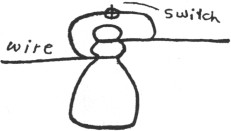
Fig. 12 |
In that same article I'd shown two other insulators, and these were
of clear glass. I no longer have the photo (It wasn't very clear, anyway.), so
I've included drawings of them to show you the styles. Figure #13, as you see
here, is an unembossed C.D. #128, and figure #14 has been newly classified as
C.D. #453 and is embossed KARHULA HEL-2. Both insulators have the strangest
pinholes! They are triangular shaped, rather than round, with evenly spaced
horizontal ridges on each of the three sides of the triangle.

Fig. 13 |
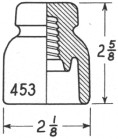
Fig. 14 |
Pentti has answers
for us here, too. He says, "In the marking HEL, the letter 'L' is shortened
from the word meaning glass -- 'LASI'." Since C.D. #453 is definitely size
HEL-3, he guesses C.D. #128, though unembossed, is probably size HEL-3. He goes
on to say:
"KARHULAN LASITEHDAS (Karhula Glass Factory) is part of the A. AHLSTRÍM Company. So is IITTALA LASITEHDAS. As far as I know, only these two
glass factories have made glass insulators in Finland."
A. AHLSTRÍM must
be a large corporation with several subsidiary companies, such as Iittala and
Karhula. I have in my hand a brochure showing many types of decorative glassware
made by Iittala, also, and the company has outlets in Great Britain,
Scandinavia, Europe and the U.S.A.
To further quote Pentti: "Glass
insulators usually -- and at least HEL-2 and HEL-3 -- have a triangular hole due
to a different attaching system. The insulator is placed on a rack upside down,
and the pin is put in the hole which is filled with some kind of a cement that
dries in a few minutes. (The triangular hole makes removal of that pin even more
of a pain than usual! M.A.) In the porcelain insulators the custom has always
been to use some soft flexible material between the hole and the pin, such as
burlap, tar coated string or felt. This is cheaper than cement (interesting!)
and the broken insulator is easier to replace."
Now, let's shift gears. I
have a special treat for you. The following picture was sent to me by Raija, and
she has agreed to let me share it with you. Isn't it precious? The fellow at the
top left is Raija's Dad, Paavo Hartto, who was eighteen at the time the picture
was taken in 1923 in Mńhtylvoto (close to the city of Pori on the west coast of
Finland). He worked for the city of Pori and had to "practice" two
years before entering college to become an electrical engineer. As an E.E. in
the 1930's he worked in the Southeast part of Finland setting up some new lines.
This work was "pioneer work", so his picture is in a museum today.
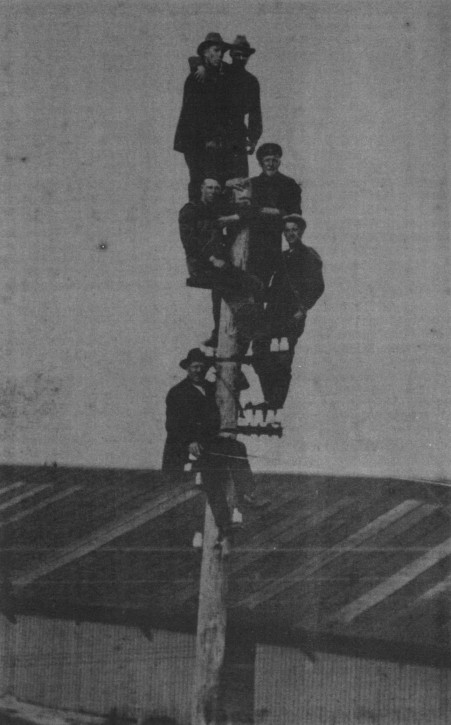
Large Image (189 Kb)
The
next four insulators you see are from Russia, and I acquired these also from
Nick and Raija.
Figure #15 is the most beautiful shade of lemony lime glass
you'll ever hope to see! It's one of those special insulators that just about
knock your socks off! The embossing on the skirt is not too clear, but it
resembles some sort of a crest with an eagle in the center of it. Being as fuzzy
as it is, I won't even attempt to sketch it here; but curved up in an arc below
the crest are the Russian letters you see next to the picture. I have no idea
what they stand for, but maybe we have some experts out there. Don Fiene
(Knoxville, Tennessee), you teach Russian. Would you care to hazard a guess?
Let's see what Pentti Muukari's letter had to say about the Russian insulators:
"A whole different story, naturally, are the insulators made in Russia. I
do not know about any of their factories. A safe marking to recognize them by is
a double eagle which on glass insulators is always cast (embossed) into the
insulator and on porcelain insulators it is usually a blue color ink under the
glaze. All of these are made before the Revolution in 1917. I am not familiar
with the production in the soviet Union today. I did see a lot of insulators
during the war (1940's) in East Karjala (now part of the Soviet Union). I wish I
had known then to put some of them in my pockets."
Figures #16 and #17 are
of white porcelain, and both have the incuse marking you see beside the photo.
Only figure #17 has a small five point star beneath the marking, which in both
cases appears on the side crowns of the insulators. I do know that the figure
resembling a "6" is the Russian letter "B". I am guessing
that 07 is for 1907.
Figure #18 is of dark brown porcelain with no visible
markings at all. I believe I am right in saying that figure #17 is a power
insulator, and figures #16 and #18 are for telephone use.
Thank you so much for
your help, Nick and Raija Antonow, and I hope you will tell Mr. Pentti Muukari
how much we all appreciate his interest, too.
| 